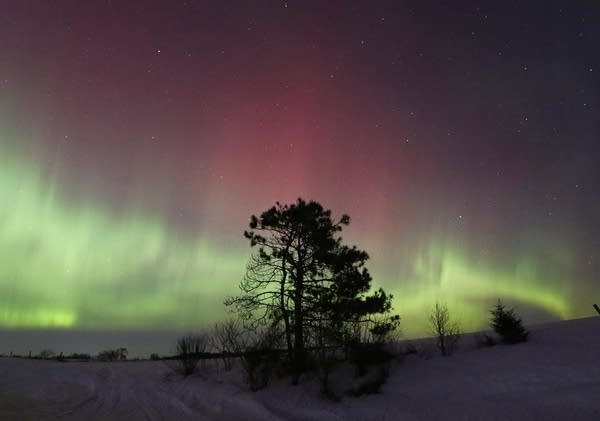Why recent forecasts on northern lights might be spotty

Go Deeper.
Create an account or log in to save stories.
Like this?
Thanks for liking this story! We have added it to a list of your favorite stories.
In recent days you may have heard a lot of chatter in the media, including on MPR News’ website, and among friends about prospects for seeing the northern lights in Minnesota this week. But some experts say those predictions may have been premature — or just wrong.
Bob King, who writes the “Astro Bob” blog for the Duluth News Tribune, told MPR’s “Minnesota Now” that a key factor in predicting whether the aurora will be visible is what’s known as the Kp index, with forecasts released by the National Oceanic and Atmospheric Administration’s Space Weather Prediction Center.
“They’re kind of like a thermometer telling you what the temperature is — in a sense, what the likelihood of seeing an aurora would be for wherever you live. The index starts at zero, which means there’s really no auroral activity. And then it goes all the way to 9,” King said. “So a Kp 0, nothing happening. Kp 9, that is an extreme auroral storm, that can affect us in a lot of different ways besides giving us the northern lights.”
In Minnesota, when the Kp index hits 5 or higher, King said, there’s a fair chance of seeing the northern lights in northern parts of the state, like Duluth. A Kp 6 reading could mean northern lights reaching as far south as the Twin Cities — if you’re near the edge of the metro area, where the sky is dark.
Turn Up Your Support
MPR News helps you turn down the noise and build shared understanding. Turn up your support for this public resource and keep trusted journalism accessible to all.
“And if it’s 7 or higher, oh my gosh,” King said. “It can paint the whole sky like the auroras that we had back in April and in March.”

NOAA has a three-day Kp forecast that can help aurora spotters gauge the potential for northern lights in the sky, and updates can occur multiple times a day.
“The forecast early in the day might say the prospects look good,” King said, “but then the update will say that indeed, tonight is not as good, or the aurora we expected tonight is actually going to arrive tomorrow.”
As of Tuesday afternoon, NOAA’s forecast showed a maximum Kp index of between 3 and 4 over the coming days.
“That is so low, you would really not see any activity,” he said. “Barely anything visible even in far northern Minnesota.”
NOAA also has a long-range, 27-day Kp forecast — which sparked some of the media coverage this week, as forecasts from several weeks ago showed potential for aurora displays this week. But King warned that the 27-day forecast is not as accurate.
“It’s super hard to say four days, five or six days in advance, there’s going to be a moderate storm, a good chance to see the aurora. That’s just too far out in advance. The aurora is just such an unpredictable thing,” King said.
King suggests monitoring NOAA’s three-day forecast to help better your chances to spot the northern lights. But keep in mind that NOAA’s Kp forecast uses Universal, or Greenwich Mean Time — the same time zone as England. You’ll want to convert their time stamps into Central Time.
“Just a quick read, someone would say, ‘Oh, big storm coming on the 13th.’ But no, indeed it’s the 12, and then into the morning of the 13th,” he said.
If the northern lights don’t show this week and you’re still interested in stargazing, King suggests looking for Jupiter, which is paired with our moon in the sky — but you might have to stay up after midnight to see it. He said you can also look for Saturn low in the southeast sky around 11:30 p.m.
“The other thing that we have is the Milky Way. If we can get this smoke out of our eyes, all of the wildfire smoke,” King said. “The view of the Milky Way is magnificent this time of year from a dark sky.”
Use the audio player above to listen to the full conversation.
Subscribe to the Minnesota Now podcast on Apple Podcasts, Google Podcasts, Spotify or wherever you get your podcasts.
We attempt to make transcripts for Minnesota Now available the next business day after a broadcast. When ready they will appear here.


